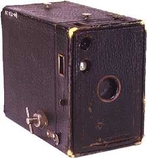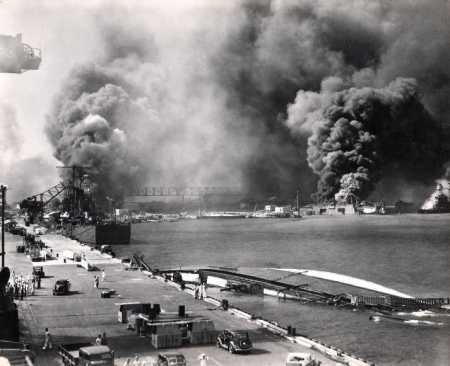
During my 28 years with Kodak, many of my customers (and Kodak) would be requested to develop old rolls of b/w film and/or cameras with film which had been discovered in attics and drawers for many years. This, of course, led to many surprising and incredible stories such as this. An image that is captured on silver sensitized film can remain latent for very long periods of time until it is developed. This is not true for color film due to dye deterioration from heat and humidity.
Isn't it amazing how a film could last so long in a camera without disintegrating? Fantastic photos taken 68 years ago. Some of you will have to go to a museum to see what a Brownie camera looked like?
These photos are absolutely incredible....Read below the first picture and at the end...
Pearl Harbor
On Sunday, December 7th, 1941 the Japanese launched a surprise attack against the U.S. Forces stationed at Pearl Harbor, Hawaii. By planning this attack on a Sunday, the Japanese commander Admiral Nagumo, hoped to catch the entire fleet in port. As luck would have it, the Aircraft Carriers and one of the Battleships were not in port. (The USS Enterprise was returning from Wake Island, where it had just delivered some aircraft. The USS Lexington was ferrying aircraft to Midway, and the USS Saratoga and USS Colorado were undergoing repairs in the United States). In spite of the latest intelligence reports about the missing aircraft carriers (his most important targets), Admiral Nagumo decided to continue the attack with his force of six carriers and 423 aircraft. At a range of 230 miles north of Oahu, he launched the first wave of a two-wave attack. Beginning at 0600 hours his first wave consisted of 183 fighters and torpedo bombers which struck at the fleet in Pearl Harbor and the airfields in Hickam, Kaneohe and Ewa. The second strike, launched at 0715 hours, consisted of 167 aircraft, which again struck at the same targets. At 0753 hours the first wave consisting of 40 Nakajima B5N2 'Kate' torpedo bombers, 51 Aichi D3A1 'Val' dive bombers, 50 high altitude bombers and 43 Zeros struck airfields and Pearl Harbor. Within the next hour, the second wave arrived and continued the attack.
Must see WWII pictures
When it was over ...
The U.S. Losses were:
Casualties:
US Army: 218 KIA, 364 WIA.
US Navy: 2,008 KIA, 710 WIA.
US Marine Corp: 109 KIA, 69 WIA.
Civilians: 68 KIA, 35 WIA.
TOTAL: 2,403 KIA, 1,178 WIA.
Battleships:
USS Arizona (BB-39) - total loss when a bomb hit her magazine.
USS Oklahoma (BB-37) - Total loss when she capsized and sank in the harbor.
USS California (BB-4 4) - Sunk at her berth. Later raised and repaired.
USS West Virginia (BB-48) - Sunk at her berth. Later raised and repaired.
USS Nevada - (BB-36) Beached to prevent sinking. Later repaired.
USS Pennsylvania (BB-38) - Light damage.
USS Maryland (BB-46) - Light damage.
USS Tennessee (BB-43) Light damage.
USS Utah (AG-16) - (former battleship used as a target) - Sunk.
Cruisers:
USS New Orleans (CA-32) - Light Damage.
USS San Francisco (CA-38) - Light Damage.
USS Detroit (CL-8) - Light Damage.
USS Raleigh (CL-7) - Heavily damaged but repaired.
USS Helena (CL-50) - Light Damage.
USS Honolulu (CL-48) - Light Damage.
Destroyers:
USS Downes (DD-375) - Destroyed. Parts salvaged.
USS Cassin - (DD -3 7 2) Destroyed. Parts salvaged.
USS Shaw (DD-373) - Very heavy damage.
USS Helm (DD-388) - Light Damage.
Minelayer:
USS Ogala (CM-4) - Sunk but later raised and repaired.
Seaplane Tender:
USS Curtiss (AV-4) - Severely damaged but later repaired.
Repair Ship:
USS Vestal (AR-4) - Severely damaged but later repaired.
Harbor Tug:
USS Sotoyomo (YT-9) - Sunk but later raised and repaired.
Aircraft:
188 Aircraft destroyed (92 USN and 92 U.S. Army Air Corps.)


















